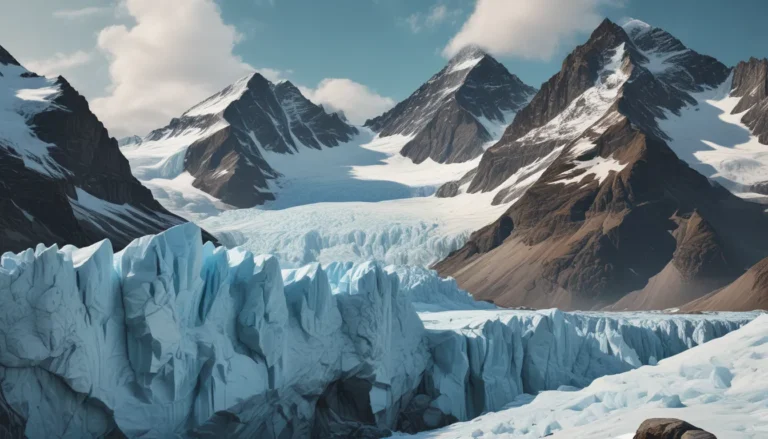A Note About Images: The images used in our articles are for illustration purposes only and may not exactly match the content. They are meant to engage readers, but the text should be relied upon for accurate information.
Are you fascinated by the Earth’s geological wonders? If so, you’ll be intrigued by the mysteries of foreland basins. These unique formations, situated at the edges of mountainous regions, offer a wealth of knowledge about our planet’s history and evolution. Join us as we explore the depths of foreland basins and uncover 11 intriguing facts about their formation, characteristics, and significance.
Unveiling the Secrets of Foreland Basins
Foreland basins are geological marvels that form as a result of tectonic processes shaping our planet. The collision of tectonic plates leads to the subsidence of the Earth’s crust, creating deep basins adjacent to mountain ranges. These basins hold valuable geological and paleontological records in their sedimentary rocks, providing insights into Earth’s history and ancient life.
The Story Behind Foreland Basin Formation
Foreland basins owe their existence to the movement of tectonic plates. As these plates collide and uplift mountain ranges, the adjacent crustal region responds by deforming and sinking, giving rise to foreland basins. This process creates elongated basins that serve as natural archives of Earth’s dynamic past.
Delving into Sedimentary Deposits
One of the defining features of foreland basins is their accumulation of thick layers of sedimentary rocks. These deposits, which include shale, sandstone, and limestone, offer valuable insights into past environments, climate changes, and the evolution of life on Earth. Fossils preserved in these rocks provide a window into ancient ecosystems and species.
A Link to Mountain Building
Foreland basins are intricately connected to the formation of mountain ranges. As mountains rise and erode, the adjacent basins experience deformation and subsidence, shaping their unique topography. The weight of the mountains plays a crucial role in creating the depressions that eventually become foreland basins.
Diverse Shapes and Sizes
Foreland basins exhibit a wide range of sizes and shapes, from small local depressions to vast regional basins stretching hundreds of kilometers. The elongated nature of these basins follows the general trend of the adjacent mountain range, reflecting the complex interplay of geological forces at work.
Beneath the Surface: Natural Resources
Beyond their geological significance, foreland basins harbor valuable natural resources such as oil, gas, coal, and minerals. The sedimentary rocks within these basins act as reservoirs for these resources, making them economically significant regions for exploration and extraction.
The Dance of Subsidence and Uplifting
The geological processes shaping foreland basins are ongoing, with subsidence and uplifting occurring over long periods of time. Tectonic activity continues to influence these basins, leading to changes in their shape and the continual deposition of sediments that preserve Earth’s history.
A Window into Plate Tectonics
Foreland basins have played a pivotal role in advancing our understanding of plate tectonics. These basins serve as natural laboratories for studying the interaction between tectonic forces, sedimentation, and mountain building processes, offering valuable insights into the mechanisms shaping our planet.
The Magnificent Himalayan Foreland Basin
Among the most remarkable examples of foreland basins is the Himalayan foreland basin, spanning several countries in South Asia. This vast basin is associated with the collision of the Indian and Eurasian tectonic plates, offering a fascinating window into the complex geological history of the region.
Carving the Landscape: The Role of Erosion
Erosion, driven by rivers and glaciers, plays a significant role in shaping foreland basins. The erosive action of water and ice carves deep valleys, transports sediments, and sculpts the landscape of these basins, contributing to their dynamic evolution over time.
Unraveling Climate Clues
The sedimentary records preserved in foreland basins contain crucial clues about past climate variations and environmental changes. By analyzing the composition and characteristics of these sediments, scientists can reconstruct the history of the basin and unravel the impacts of climate fluctuations on its landscape.
Conclusion: Embracing Earth’s Geological Marvels
In delving into the complexities of foreland basins, we gain a deeper appreciation for the processes that have shaped our planet over millions of years. Whether you’re a geology enthusiast or simply curious about the world around us, exploring the wonders of foreland basins offers a captivating journey into Earth’s geological history.
From the vast sedimentary deposits to the dynamic interactions between tectonic plates, foreland basins are a testament to the ever-changing nature of our planet. Next time you encounter a foreland basin, take a moment to marvel at the secrets hidden within its layers and contemplate the incredible geological forces that have shaped our world.
FAQs: Exploring Foreland Basins
- What is a foreland basin?
-
A foreland basin is a low-lying area situated between a mountain range and a stable continental craton, formed by the subsidence of the lithosphere in response to the weight of the mountains.
-
How are foreland basins formed?
-
Foreland basins are created through foreland basin subsidence, where the lithosphere beneath a mountain range sinks under the pressure of the mountains, causing the adjacent basin to fill with sediment.
-
What are some notable examples of foreland basins?
-
Notable examples include the Western Interior Basin in North America, the Ganges Basin in India, and the Subandean Basin in South America, each offering unique insights into Earth’s geological history.
-
What are the major sedimentary deposits found in foreland basins?
-
Foreland basins are known for their diverse sedimentary deposits, ranging from sandstones and shales to conglomerates and coal, providing valuable clues about the region’s geological past.
-
How do foreland basins contribute to our understanding of plate tectonics?
- By studying the sedimentary records and deformation patterns within foreland basins, geologists gain crucial insights into the forces and movements shaping the Earth’s crust, furthering our understanding of plate tectonics.
Embracing Earth’s Geological Treasures
In our quest to understand the mysteries of our planet, foreland basins stand out as captivating geological wonders that offer a window into Earth’s dynamic past. Through their formation, unique characteristics, and invaluable geological records, foreland basins enrich our understanding of the forces that have shaped our world. As we continue to unravel the secrets of these fascinating formations, we embark on a journey of discovery that illuminates the intricate processes at play beneath our feet. Venture into the world of foreland basins and unlock the hidden wonders of Earth’s geological history.






